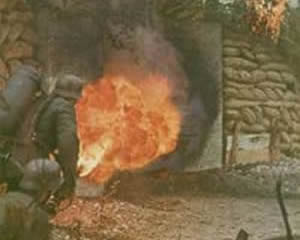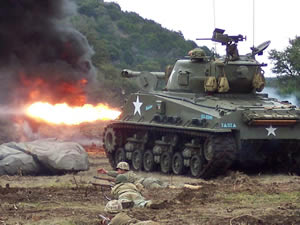Science of Conflict
Napalm
Incendiary fluids
were first used by the Greeks during the Byzantine Empire. Forces during
this era used a flammable mixture called Greek
fire. Napalm is an incendiary fluid made of a mixture of fuels, such
as kerosine, and thickners, such as rubber. In fact napalm was used as
a thickent in place of natural rubber, hence the name. Depending on the
ratio of thickner to fuel, napalm can be manufactured into a gel or liquid
form that can be sprayed from a hand held flame thrower. Flame throwers
were used extensively during WWI and WWII to clear trenches and stubborn
pockets of resistance. It was particularly effective in the battle of
Iwo Jima.

Modern napalm is made from a mixture of kerosine and polystyrene. It is particularly nasty as it sticks to objects and continues to burn with great intensity at over 1,200 oC
Napalm was sprayed from tanks during WWII and was feared by enemy troops. So intense was the fear of napalm that SS troops would execute captured allied tank crews that used napalm.



Why is napalm a particularly vicious weapon to use?
Discuss the psychological impact on enemy soldiers?
How does napalm cause death?
What is the effect of carbon monoxide on the human body?
Under what battle conditions is this type of weapon better used?